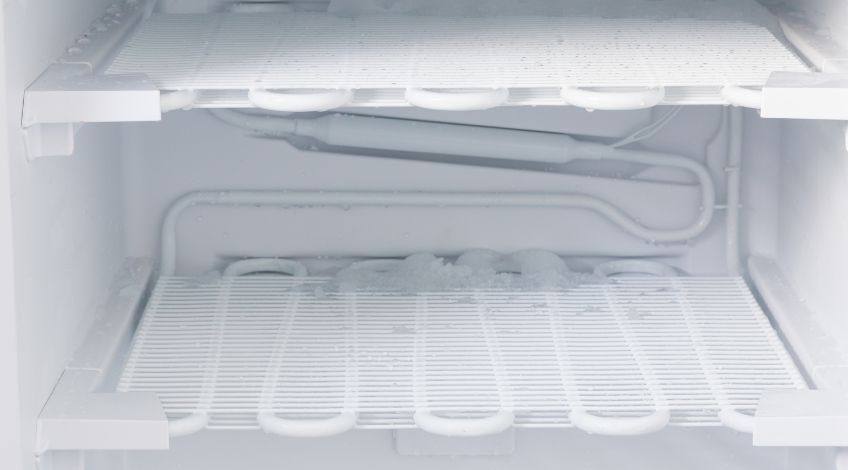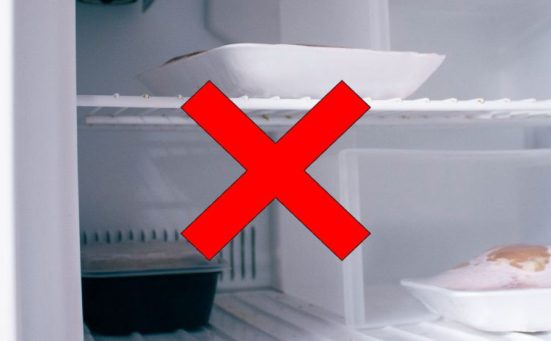
Samsung Refrigerator Freezes Up? (here’s how to fix it)
If you own a Samsung refrigerator and it is freezing up, it can be a costly inconvenience. Before you can fix this problem, you need to understand what’s causing the fridge to freeze.
In this article we take a close look into all of the reasons why your Samsung refrigerator might freeze up and offer solutions to these issues.
Why Is My Samsung Refrigerator Freezing Up?
There are several reasons why your Samsung refrigerator might be freezing up which include;
| Probable Cause | Solution |
|---|---|
| Incorrect Temperature Settings | Check the temperature settings and change if necessary |
| Inadequate Airflow | Ensure the air vents are not obstructed |
| Defective Defrost System | Check the defrost heater, timer and thermostat and replace if necessary |
| Defective Thermostat | Check the thermostat and replace if necessary |
| Defective Door Seals | Inspect and replace the door seals if necessary |
| Defective Damper Assembly | Check the damper assembly & remove any ice or other obstructions |
| Unlevel Appliance | Check the level of the fridge and adjust if necessary |
| Too Many Items Crammed Into The Appliance | Arrange the items of the fridge to allow unrestricted airflow |
| Defective Thermistor | Check the thermistor and replace if necessary |
| Dirt Buildup On The Condenser Coils | Clean the condenser coils |
| Clogged/Faulty Drain Pan | Check & clean the drain pan |
Let’s take a closer look at each of these issues;
Incorrect Temperature Settings
Your Samsung refrigerator is designed to operate at a set temperature to keep the contents at their best and save energy. If the temperature is set to a level below the recommended range, it could cause the fridge to freeze up.
This will not only cause certain foods to be unusable, but could also affect the efficiency and lifespan of the appliance. Consult your user manual for the correct temperature settings for your particular model and adjust the settings accordingly.
These will typically be somewhere around 2o C (36o F) to 4o C (40o F) for the fridge and around -17o C (0o F) for the freezer. You should regularly check these temperatures to avoid any problems.
Inadequate Airflow

If the airflow is obstructed, cold air is unable to circulate which could cause the fridge to freeze up. This can be caused by too many items crammed into the fridge and freezer sections resulting in blocked vents or a malfunctioning evaporator fan motor.
You will need to check that there are no items blocking the vents and that air can flow freely around the appliance. If the vents are clogged with dirt or food debris, you should remove the offending items using a vacuum.
Ensuring the vents are clear and allowing air to flow freely will help prevent any problems with the evaporator fan motor as well.
You should also never place food with a high water content too close to the vents as this can lead to freezing. This includes foods like meat, vegetables and some fruits. These items should be placed at least 2 inches away from the vents.
Defective Defrost System
The defrost system is designed to prevent ice buildup on the cooling coils. If the defrost system develops a fault, it can lead to ice building up which then causes the fridge to freeze up.
To prevent this from becoming a problem, you will need to regularly check the defrost timer, defrost heater and defrost thermostat. To do this you will need to disconnect the power supply and empty the refrigerator.
You can then access the evaporator coils and inspect the defrost thermostat, timer and heater. You can test these components for continuity using a multimeter.
If any of these components proves to be defective, they will need to be replaced.
Defective Thermostat
The thermostat regulates the temperature of the appliance and is crucial to the proper functioning of the unit. It maintains the correct temperature for the fridge keeping perishable foods preserved at a safe level.
If the thermostat develops a fault, it can cause fluctuations in the temperature which can cause the fridge to freeze up.
You should check the thermostat for continuity using a multimeter and if it is malfunctioning, it needs to be replaced.
Defective Door Seals

The door seals on your Samsung refrigerator are designed to make an airtight seal to prevent cool air from escaping or warm air from entering. If the door seal is defective, warm air can enter the fridge leading to condensation which causes ice buildup.
The warm air can affect the quality of the foods in the fridge which are supposed to be kept at a low temperature to prevent germs and bacteria from multiplying.
Added to which, the ice build up or influx of warm air causes the fridge’s components to work harder in an attempt to cool the temperature to its recommended preset level.
You should regularly check the door seal and remove any dirt, dust, grime, food particles, etc using a cloth soaked in warm soapy water. If the door seal is damaged or frayed, it will need to be replaced.
Defective Damper Assembly
The damper assembly regulates the circulation of cold air between the fridge and freezer sections. The damper assembly needs to be running smoothly for the optimal running temperature to be achieved.
If this assembly develops a fault or becomes obstructed in any way, it can lead to a buildup of excessively cold air in the fridge compartment. This can lead to the fridge freezing up and spoiling any food stuff inside.
You will need to check the damper assembly which is typically located inside the refrigerator’s air tower or in the air duct. Check for any ice buildup, damage or any obstruction around the damper door.
Use a multimeter to check for continuity, as well as checking the thermistor and control board to make sure there is proper communication between these components.
Unlevel Appliance
It is essential that your Samsung refrigerator is completely level if you want it to run properly. If the unit isn’t level it can prevent the doors from closing correctly due to misalignment. This will allow cool air to escape and warm air to enter.
If warm air enters the fridge it will cause condensation which leads to ice buildup. Not to mention making the components work harder in an effort to cool the fridge down which increases energy consumption.
You will need to check that the appliance is level which can be adjusted using the adjustable feet on the appliance.
Too Many Items Crammed Into The Appliance

Storing too many items in the fridge can restrict the air flow leading to the fridge freezing up. Always ensure the shelves and drawers are not crammed too full with items.
You should arrange the items in such a way that they allow air to flow freely around the compartment.
Defective Thermistor
The thermistor collects information about the freezer, fridge and evaporator. It monitors the temperature of the fridge and sends this information to the control board.
If the thermistor develops a fault, it will send the wrong information to the control board which could result in the fridge freezing up.
To inspect the thermistor you will first need to disconnect the appliance from the power supply and then locate the thermistor which will be attached to the top of the evaporator coil. You should check it for any obvious signs of damage and then use a multimeter to check for continuity.
If it proves to be defective, the thermistor will need to be replaced. We recommend contacting a technician to investigate and replace the thermistor for you.
Dirt Buildup On The Condenser Coils
The condenser coils are found at the back of the refrigerator and release heat to allow the fridge and freezer to remain at their set temperatures.
Over time, the condenser coils can become clogged with dirt and dust which effectively insulates them preventing the heat from escaping. This leads to the fridge taking longer than usual to cool down. Or conversely, leading to the fridge freezing up.
You will need to clean the condenser coils using a dry cloth or brush after disconnecting the power supply. If there is too much dirt, you might be better off using a vacuum cleaner to remove the bulk of it.
This task should be performed once every 3 months to prevent this from happening again.
Clogged/Faulty Drain Pan
Situated close to the condenser and condenser coils, is the drain pan. The drain pan is designed to collect water from the melting ice in the fridge which then evaporates into the air.
If the drain pan becomes clogged with dirt, dust or debris, it will lead to water collecting at the bottom of the fridge which can lead to freezing problems.
To check the drain pan, start inside the fridge and look at the bottom of the compartment. There you will see a drain hole, check that this drain hole isn’t clogged by any dirt or debris.
If you do find any blockage carefully remove it by prising it out using a pipe cleaner or similar. Make sure that you don’t force the blockage further into the drain hole.
Check the drain pan for any signs of damage and replace it if necessary. It is also a good idea to empty the drain pan occasionally to prevent it from becoming too dirty which can impede its functionality.
SEE ALSO: Samsung Refrigerator Freezing Food? (do this asap)
Frequently Asked Questions
If your Samsung fridge keeps freezing up, it could be because; the temperature has been set incorrectly, there is inadequate airflow, the defrost system is defective, the thermostat is defective, the door seals are leaking, the damper assembly is defective, the appliance is unlevel, there are too many items crammed into the appliance, the thermistor is defective, there is dirt building up on the condenser coils or the drain pan is clogged or damaged.
The most commonly reported problem with Samsung refrigerators is a faulty temperature sensor leading to ice buildup inside the refrigerator.
A Samsung refrigerator will defrost several times a day but at times you will need to perform a manual defrost to remove excess ice.
A Samsung fridge should have a temperature of 3°C (38°F) for the fridge and -19°C (-2°F) for the freezer.
Disconnecting the power supply by unplugging your Samsung fridge and leaving it unplugged for around 30 minutes will reset the appliance.
Also, follow us on Pinterest ...



